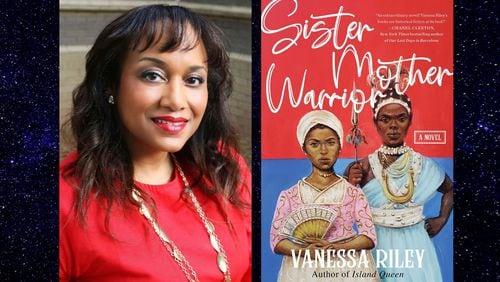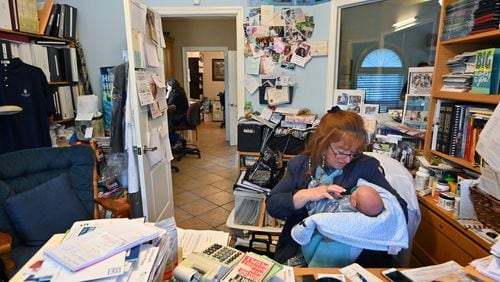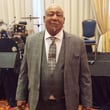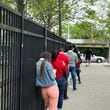Earning multiple degrees in engineering, including a doctorate in mechanical engineering from Stanford University, may not be the most likely precursor to a literary career, but the discipline has served Vanessa Riley well. “Engineering has taught me to ask two fundamental types of questions,” says the Atlanta-based novelist and author of more than 20 books. ”How are things made? Why does a system work as it does?”
These questions are at the core of “Sister Mother Warrior” (William Morrow, 480 pages), a historical fiction that interrogates the mechanics of slavery and indulges Riley’s curiosity about Caribbean, Georgian and Regency history.
The story unfolds on the island of Saint-Domingue in the 18th century, the island that is now home to Haiti and the Dominican Republic. Then known as as La Perle des Antilles (The Pearl of the Antilles) for the vast wealth generated by the cultivation of sugar cane, coffee and tobacco, the French colony was on the brink of destruction. Although the names Toussaint Louverture and Jean-Jacques Dessalines remain synonymous with the uprising that established Haiti’s independence, Riley chose to broaden our understanding of the era by giving voice to two women — Marie-Claire Bonheur (the first Empress of Haiti) and Gran Toya (a West African-born warrior) who helped lead the revolution.
“I’m here because my ancestors survived,” says Riley. “The world must learn what happened so we don’t repeat mistakes and can truly understand our blessings of living now on the shoulders of those who came before us.”
In advance of her book talks at the Atlanta History Center (Tuesday), Gwinnett County Public Library (Wednesday) and Decatur Library (Thursday), Riley shared her thoughts on the idiosyncrasies of racial hierarchy, her end-of-day writing ritual and whom she would cast as lead actors if her book is adapted for film.
Q: What were the racial classifications for people living on Saint-Domingue in the 18th and 19th centuries? How were individuals able to transcend the established hierarchy and improve their social/civic status?
A: Whites, the Blancs, had two categories: Grand Blancs who owned land and were wealthy, and Petite Blancs. Petite Blancs were in trade, or they worked for the Grand Blancs. Mobility happened by gaining wealth or marrying into wealth. For people of color, or Blacks, there were other designations. Affranchi were free Coloreds (Creole, people with mixed heritage and light-colored skin) and free Blacks. Freedom for the Affranchi came from being born free or being freed by their master through money or the Code Noir. One of the most coercive aspects of the Code Noir, or codified coercion, was the freeing of an enslaved woman and her child if she had a baby by her master. Enslaved Blacks were at the bottom of the social wrung.
Q: What was the average life expectancy for an enslaved person in Saint-Domingue versus the United States?
A: The life expectancy in the United States for the enslaved is reported to be from 40 to 44 years. In Saint-Domingue and most of the West Indie’s colonies, the enslaved lived an average of 30 to 33 years. It’s hard to measure levels of cruelty and the levels of punishment that lead to death. Both America and Saint-Domingue abused their slaves, and often resorted to unimaginable ways to maximize pain.
Nonetheless, the number of enslaved rebellions occurring across the Caribbean led these colonizers to inflict severe punishments in an attempt to control their “chattel.” The accounts are horrifying.
The islands are a deadlier place because of bugs and diseases like yellow fever prevalent in these tropical climates, accounting for thousands of deaths each year.
Q: Did you cultivate a self-care routine to preserve your emotional well-being while researching and writing the novel?
A: Ending a writing day with calming hot tea has become a ritual. I also believe in enjoying a good meal and great chocolate to transport me mentally to a place of joy and safety. “Sister Mother Warrior” was the hardest novel that I have had to write. I was tested in ways I’d never imagined. At times, there felt like roadblocks had been set in my way to prevent this story from coming into existence. But I’m stubborn. I’m determined to return our ancestors to us in ways that show their courage, their heart and their humanity.
Q: Opera on Saint-Domingue has a rich history, and the island was regarded as a cultural and world leader in theater. Why were you interested in sharing this fact with readers?
A: This was an unexpected fact I discovered in my research. Saint-Domingue, the Pearl of the Antilles, is a cultural powerhouse. As the march to rebellion and independence came closer, [opportunities] for Black and Colored [performance artists] disappeared. I’d always thought of art and theater as an escape. Yet in Saint Domingue, it is yet another mirror of the effects of colorism and how nothing is immune to the prejudices of society.
Q: Your prior novel, “Island Queen,” is being adapted for screen by Adjoa Andoh — who read the audiobooks of both “Island Queen” and “Sister Mother Warrior” — and the team that brought us “Bridgerton.” Why do you think historical dramas, particularly those that foreground the stories of powerful Black women, are enjoying such popularity in literature and film today?
A: These historical stories showcasing Black women with agency are few. There’s a hunger to have the narrative corrected and a desire to see Black actors in parts that aren’t the wise old grandmother figure or the street-savvy best friend.
Q: Should lightening strike twice and Sister Mother Warrior is adapted for film, who would you cast as Abdaraya “Gran” Toya, Marie-Claire Bonheur and Jean-Jacques Dessalines?
A: First, I’d love lightning to strike because Sister Mother Warrior is cinematic and epic. I’d love to see it on the screen.
Gran Toya could be [played by] Adjoa Andoh or Viola Davis or Lupita Nyong. Marie-Claire Bonheur could be [played by] Haitian-American actress Garcelle Beauvais or Kerry Washington. Jean-Jacques is a harder one but we should give try-outs to Daniel Kaluuya, John Boyega, Chiwetel Ejiofor, or John David Washington. John David should bring his father, Denzel, with him for moral support.
Credit: ArtsATL
Credit: ArtsATL
MEET OUR PARTNER
ArtsATL (www.artsatl.org), is a nonprofit organization that plays a critical role in educating and informing audiences about metro Atlanta’s arts and culture. Founded in 2009, ArtsATL’s goal is to help build a sustainable arts community contributing to the economic and cultural health of the city.
If you have any questions about this partnership or others, please contact Senior Manager of Partnerships Nicole Williams at nicole.williams@ajc.com.







